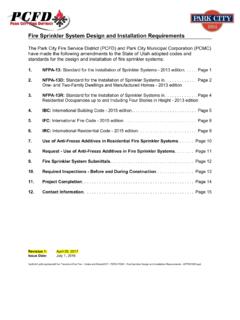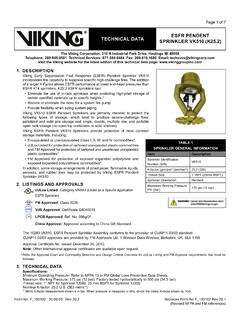Transcription of NFPA 13 STANDARD FOR THE INSTALLATION OF …
1 NFPA 13 STANDARD FOR THE INSTALLATION OF sprinkler SYSTEMS: SFM IN HOUSE Q&A OCTOBER 18, 2005 Question 1: From time to time, this office receives sprinkler plans showing "relocated sprinklers" and implying reuse of existing sprinklers. 13: states "Only new sprinklers shall be installed" which does not allow reuse of existing sprinklers. Please comment as necessary if there is an exception to 13 Answer: NFPA 13 requires new sprinklers in all installations. The intent includes renovation projects. It is a policy of this office, and most sprinkler contractors in this state, that whenever renovations to existing systems are proposed, no matter how simple, if the sprinkler head is manipulated, moved, etc., the existing head is replaced with a new one. The only alternative is to remove and test a reasonable quantity of existing heads in accordance with NFPA 25 , 1998 edition.
2 SFM Determination: This office shall continue to require sprinkler heads to be replaced, if they are manipulated in any way (armover, drop, shift to center tile, etc.). Question 2: If you have an existing building that has an existing, required sprinkler system and renovations are proposed now, such as a combustible canopy, covered walkway, eave, etc. in excess of 4 feet, does the sprinkler system have to be modified or are existing sprinkler systems exempt? Just as architectural renovations and additions are required to comply with current code, the same holds true for sprinkler renovations and additions. With your example above, the new combustible overhangs exceeding 4 feet in width must be provided with sprinklers. Question 3: NFPA 13 (1) States that sprinklers shall be installed throughout the premises. If you have a multiple occupancy Assembly/Education and the Assembly portion requires the sprinkler system , is it required that sprinkler protection be provided throughout the entire building to include the education portion?
3 Do you need a 2 hour separation between the two occupancies to not have to provide sprinklers in the Education portion of the building? NFPA 101 requires that assembly occupancies exceeding certain thresholds must be sprinklered throughout the entire building. Also, NFPA 101:Table , Construction Type Limitations, requires sprinklers for the assembly occupancy and/or other portions of the building, depending on the building construction type. In this case, the building s partial sprinkler protection is a code acknowledged equivalency to more stringent construction types and/or increase assembly occupant load. Question 4: What are the serious considerations when a sprinkler system is proposed for a site served by a water well, not a public water system ? I know we received a project, at least once, for a large hunting club that was technically a Hotel/Dormitory occupancy.
4 NFPA 13 states that water supply connections from penstocks, flumes, rivers, lakes, or reservoirs shall be acceptable, arranged to avoid mud and sediment and shall be provided with approved double removable screens or approved strainers installed in an approved manner. The sprinkler Handbook commentary includes water wells. These types of water supplies are acceptable provided owner can document that code required water supply duration can be met and that the hydraulic demand does not exceed the supply. Question 5: What type of separation would be required for a non-sprinklered assembly space that is inside (and shares egress with) a large industrial building? The industrial occupancy is sprinklered per NFPA 101 (2), due to areas with hazardous materials or hazardous operations. Shared egress defines a mixed occupancy per NFPA 101 Therefore, NFPA 101 requires construction type, protection, etc.
5 For the most stringent occupancy to be provided throughout the building. The Multiple Occupancy section at NFPA 101 Chapters 12 and 40 refer to Section , which has no specific separation requirements for these two occupancies. The assembly occupancy, by itself, does not require sprinklers. The industrial occupancy, by itself, does not require sprinklers. However, neither of the occupancies are incidental to each other. Because the industrial occupancy is considered a greater hazard than the assembly occupancy, NFPA 101 requires the industrial occupancy to be either sprinklered, 1-hour separated, or both. If this office determines that either 1-hour separation or sprinklering the hazard area is required and sprinklers are provided in the industrial occupancy, then a 1-hour separation is not required. Question 6: When we cite separation or sprinkler protection - what area will a single sprinkler head cover?
6 It is my understanding that if a room has one sprinkler head a plumber can install it, if there are 2 or more than a sprinkler contractor has to install it. What is the procedure if the second option is used? Typically NFPA 13 acknowledges small hazardous rooms as Ordinary Hazard and sprinklers are limited to 130 sq. ft. of coverage per head. As per the sprinkler exemption form instructions, a plumber can only install one sprinkler is a room of 130 sq. ft maximum. However, several 1-head rooms can exist throughout a building and a plumber can install each of these. Two heads in one room requires a quick hydraulic calculation and a sketch of piping to water supply. This information is online with the sprinkler exemption form. Question 7: Renovation to sprinklered tenant space, suspended acoustical tile ceiling is removed leaving sprinkler heads at 10 feet above finish floor with above exposed to roof deck (structural, electrical & mechanical).
7 Are any sprinkler modifications required? Do exposed areas above existing sprinkler heads (former ceiling plenum) need sprinkler protection? NFPA 13 allows a maximum of 36 inches between sprinkler deflector and ceiling. With the finish ceiling uninstalled, if the deflector to underside of deck height exceeds 36 inches, then sprinklers must be provided at underside of roof deck or owner must provide equivalency appeal. Question 8: Is there anything to keep a designer from defining an office area as ordinary hazard and then using STANDARD response sprinklers in that area? 13: * Sprinklers in light hazard occupancies shall be one of the following: 1. Quick-response type as defined in 2. Residential sprinklers in accordance with the requirements of 3. STANDARD response sprinklers used for modifications or additions to existing light hazard systems equipped with STANDARD response sprinklers 4.
8 STANDARD response sprinklers used where individual STANDARD response sprinklers are replaced in existing light hazard systems How is the space being used? Employee Break Room, Toilets, Offices, Vestibule, Telephone. Is it just one room? Several, approx 3000 What is overall occupancy of building? A Lowes Big Box Retail /Rack. Why is designer deeming this space as ordinary hazard? What is justification to show maximum possible demand from the area? Examples above are all incidental business spaces and must be provided with QR heads. The commentary to on page 197 is helpful, especially the last paragraph. Question 9: Project involves a 20,000 sq. ft. addition to an existing 40,000 sq. ft. climate controlled, sprinklered Storage Occupancy. The POR created dead ends and violated common path of travel code requirements. POR was required to revise his design documents and resubmit for review.
9 The POR noted on the drawings that the sprinkler contractor shall submit sprinkler shop drawings. No reflected ceiling plan was submitted in the design documents. No sprinkler head locations were noted on any drawings. The light fixture and sprinkler head location design were left to the contractor. The POR was required to submit sprinkler design intent documents reviewed by a POR competent in sprinkler design prior to submission of the sprinkler shop drawings. 1. Can the existing sprinkler system be enlarged accommodate 60,000 sq. ft. and comply with code? Assume storage is high pile d greater than 12 feet in height. NFPA 13 (4) limits high piled storage hazard class to 40,000 sq. ft maximum per sprinkler system riser. Therefore, a second riser has to be provided. 2. Is an additional riser required? Yes, per above. 3. Is a fire pump now required?
10 The size of a sprinkler system or the hazard class of the occupancy is not the driver for pump requirement. If the water supply is less than the hydraulic demand of the hydraulically remote area, then additional means must be introduced to system , fire pump, second tie-in to municipal supply, gravity tank, etc. 4. Is the plan review STANDARD such that plans must be complete enough so that the contractor has no design decisions to make? No. See SFM licensing rule excerpt, below: 55:V:3011. Qualifying Persons A. Each certified business or each business seeking certification, other than portable fire extinguisher and pre-engineered fixed fire extinguishing system firms, shall employ at least one qualifying person. No systems shall be planned, installed or submitted to this office for review if the business does not employ a qualifying person as provided herein.





